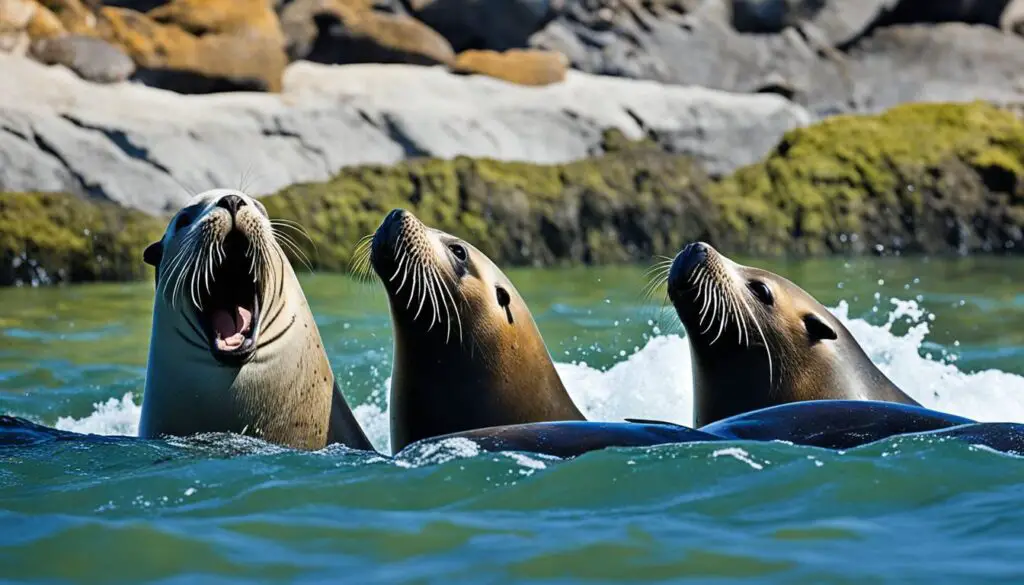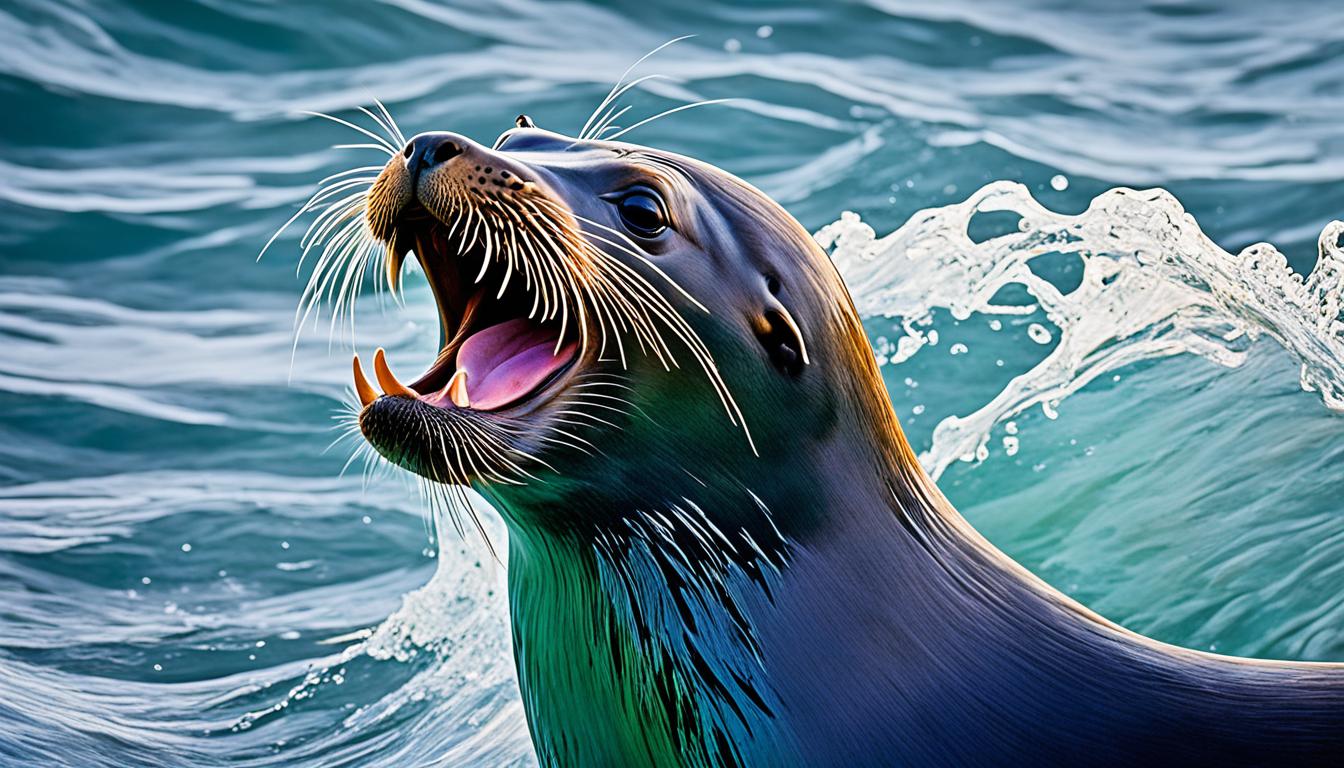California sea lions have a fascinating way of communicating with each other through their barks. But why do they bark? This question shows how vital it is to understand their vocalizations. Sea lions use their barks to talk to each other, which is key to their social life and behavior in the ocean.
By looking into sea lion communication, we learn a lot about their social lives. Their barks help us see how they interact with each other. This makes us appreciate their complex social world more.
Understanding Sea Lion Communication
Sea lion communication is really interesting and tied to their social lives and behaviors. They use sounds a lot to talk to each other, both on land and in the water. By listening to these sounds, we can learn a lot about sea lion behavior and their social groups.
Importance of Vocalizations
Vocalizations are key to sea lion communication. Sea lions make different sounds to show feelings and needs. These sounds help them set up social orders and mark their territory. In mating season, males use special barks to draw in females, showing off their strength.
These sounds are vital for keeping groups together and helping individuals survive.
Types of Sounds Made by Sea Lions
Sea lions make many different sounds. These include:
- Barks: Used for talking to each other and during mating.
- Growls: Linked to being aggressive or defending territory.
- Bleats: Mothers use these to talk to their babies.
- Trumpets: For social stuff or to signal trouble.
Each sound has its own job and helps with group interactions. This shows how complex sea lion sounds are.
| Sound Type | Purpose |
|---|---|
| Barks | Mating calls and social interaction |
| Growls | Aggression and territory defense |
| Bleats | Mother-pup communication |
| Trumpets | Social signaling and distress calls |
Why do sea lions bark?
Sea lions bark for many reasons, showing us how they communicate and behave. Their sounds are key during the breeding season, when they make more noise.
Barking During Breeding Season
Male sea lions bark a lot during the breeding season. They do this to mark their territory and warn other males to stay away. They also bark to attract females. This loud barking makes the area lively and shows who’s the strongest.
The louder and more often they bark, the more females notice them. This shows they are strong and fit.
Communication between Mothers and Pups
Mother sea lions use special calls to talk to their pups when they come back from hunting. These loud calls help the pups know it’s their mom. The pups answer with their own sounds, making sure they meet up safely.
Both sounds and smells are important for these reunions. This shows how complex sea lion communication is.
Sea Lion Vocal Patterns and Their Significance
Sea lion vocal patterns show us their feelings and social life. These sounds are key in both personal and group settings. They show how smart and adaptable these animals are.
Distress Calls and Alarms
Sea lions make loud calls when they feel danger. These calls warn others in the group of a threat. It tells them to quickly get into the water for safety.
This way of communicating is crucial for their survival. It keeps the whole group safe.
Social Interactions and Vocalization
In safe times, sea lion sounds help them connect with each other. These sounds help build and keep relationships within the group. They also help set who’s in charge.
Sea lions use different calls for greetings, showing they’re not happy, or getting ready to mate. Each call tells us something about their way of communicating. It shows how important social ties are to them.
Marine Mammal Vocalizations: The Role of Sea Lions
Understanding how marine mammals communicate is key to knowing their behavior and social life. Sea lions, being a key species, show a wide range of sounds. These sounds help them talk to each other in special ways, unlike seals and walruses.
Comparison with Other Pinniped Species
California sea lions make more kinds of sounds than many other sea creatures. This helps them talk better, letting them share complex messages. Here’s how their sounds compare with those of other sea mammals:
| Species | Vocalization Types | Diversity Level | Effectiveness in Communication |
|---|---|---|---|
| California Sea Lion | Barks, growls, roars, and barks | High | Very Effective |
| Harbor Seal | Grunts and low-frequency sounds | Moderate | Moderately Effective |
| Walrus | Bell-like sounds and grunting | Moderate | Effective in specific contexts |
Research Challenges in Understanding Vocalizations
Studying how marine mammals talk to each other is hard. In big groups, it’s tough to pick out individual sounds and what they mean. With so many sounds happening at once, it’s like trying to hear one voice in a loud crowd. So, scientists need to focus to understand sea mammals better and learn how they communicate.

Sea Lion Vocalizations Ethology: Insights and Discoveries
Studies on sea lion vocalizations have revealed a lot about their social lives and breeding habits. These marine mammals use different sounds to build social hierarchies in their groups. By listening to their voices, we can learn how they talk to each other and form bonds.
Sea lions make many sounds, each with its own meaning. For example, their calls help them work together when hunting, making them better at finding food. During breeding, their sounds tell us about their mating habits and how they connect with each other.
Looking into sea lion vocalizations is key to understanding how marine mammals communicate. As scientists keep studying, we’ll learn more about sea lions and how to protect them and their homes.
Conclusion: The Significance of Understanding Sea Lion Barking
Learning why sea lions bark helps us understand their social lives. It shows how they talk to each other, keep their families close, and help their babies survive. By exploring California sea lions, we see how important their sounds are for their family life.
Research shows how complex their communication is. It makes us value their vocalizations more. Knowing about sea lion behavior teaches us about marine mammal communication. It also shows why we need to protect their homes and families.
Understanding sea lion barking is key to saving them. By knowing what their sounds mean, we can help protect these amazing animals. This way, they can keep living in their natural world for a long time.









